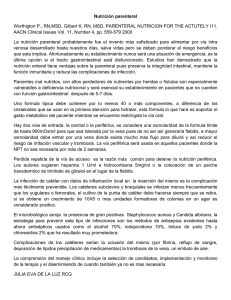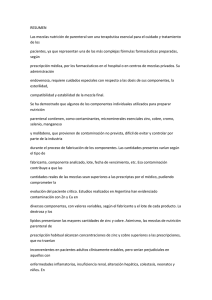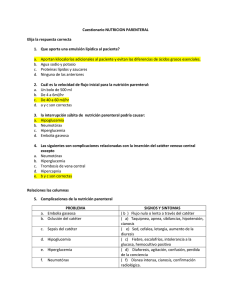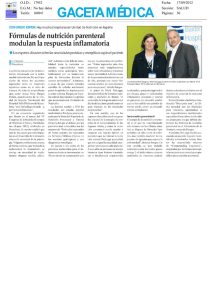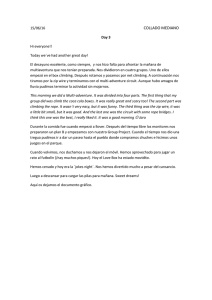Respiratory myoclonus, a side effect of galantamine
Anuncio
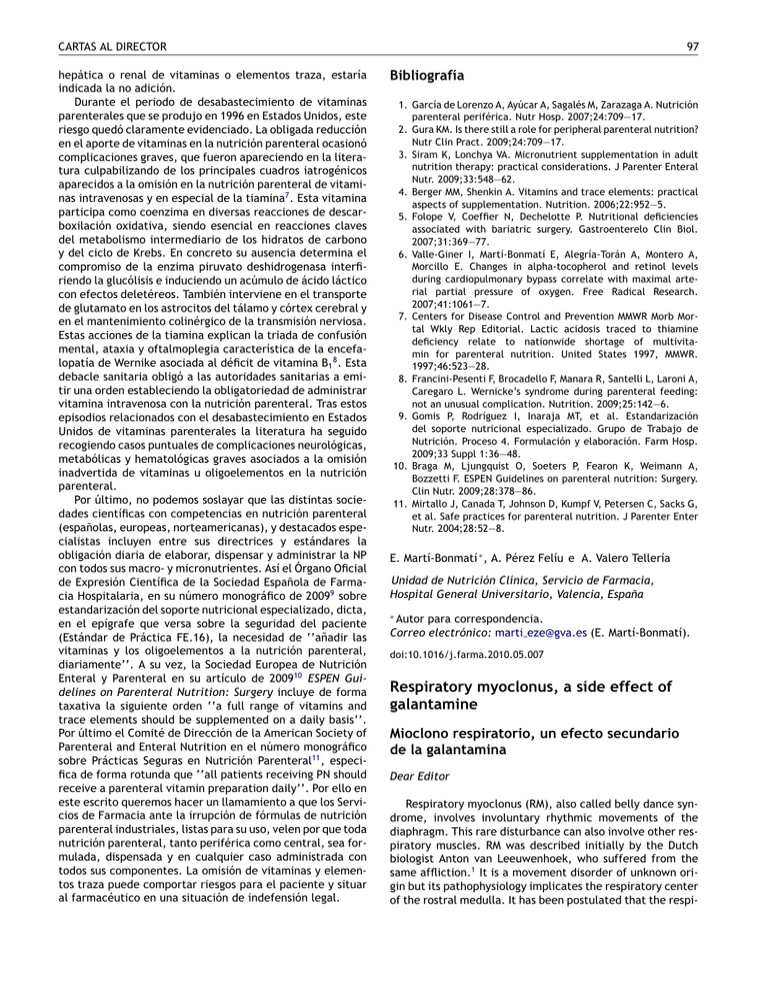
CARTAS AL DIRECTOR hepática o renal de vitaminas o elementos traza, estaría indicada la no adición. Durante el periodo de desabastecimiento de vitaminas parenterales que se produjo en 1996 en Estados Unidos, este riesgo quedó claramente evidenciado. La obligada reducción en el aporte de vitaminas en la nutrición parenteral ocasionó complicaciones graves, que fueron apareciendo en la literatura culpabilizando de los principales cuadros iatrogénicos aparecidos a la omisión en la nutrición parenteral de vitaminas intravenosas y en especial de la tiamina7 . Esta vitamina participa como coenzima en diversas reacciones de descarboxilación oxidativa, siendo esencial en reacciones claves del metabolismo intermediario de los hidratos de carbono y del ciclo de Krebs. En concreto su ausencia determina el compromiso de la enzima piruvato deshidrogenasa interfiriendo la glucólisis e induciendo un acúmulo de ácido láctico con efectos deletéreos. También interviene en el transporte de glutamato en los astrocitos del tálamo y córtex cerebral y en el mantenimiento colinérgico de la transmisión nerviosa. Estas acciones de la tiamina explican la triada de confusión mental, ataxia y oftalmoplegia característica de la encefalopatía de Wernike asociada al déficit de vitamina B1 8 . Esta debacle sanitaria obligó a las autoridades sanitarias a emitir una orden estableciendo la obligatoriedad de administrar vitamina intravenosa con la nutrición parenteral. Tras estos episodios relacionados con el desabastecimiento en Estados Unidos de vitaminas parenterales la literatura ha seguido recogiendo casos puntuales de complicaciones neurológicas, metabólicas y hematológicas graves asociados a la omisión inadvertida de vitaminas u oligoelementos en la nutrición parenteral. Por último, no podemos soslayar que las distintas sociedades científicas con competencias en nutrición parenteral (españolas, europeas, norteamericanas), y destacados especialistas incluyen entre sus directrices y estándares la obligación diaria de elaborar, dispensar y administrar la NP con todos sus macro- y micronutrientes. Así el Órgano Oficial de Expresión Científica de la Sociedad Española de Farmacia Hospitalaria, en su número monográfico de 20099 sobre estandarización del soporte nutricional especializado, dicta, en el epígrafe que versa sobre la seguridad del paciente (Estándar de Práctica FE.16), la necesidad de ‘‘añadir las vitaminas y los oligoelementos a la nutrición parenteral, diariamente’’. A su vez, la Sociedad Europea de Nutrición Enteral y Parenteral en su artículo de 200910 ESPEN Guidelines on Parenteral Nutrition: Surgery incluye de forma taxativa la siguiente orden ‘‘a full range of vitamins and trace elements should be supplemented on a daily basis’’. Por último el Comité de Dirección de la American Society of Parenteral and Enteral Nutrition en el número monográfico sobre Prácticas Seguras en Nutrición Parenteral11 , especifica de forma rotunda que ‘‘all patients receiving PN should receive a parenteral vitamin preparation daily’’. Por ello en este escrito queremos hacer un llamamiento a que los Servicios de Farmacia ante la irrupción de fórmulas de nutrición parenteral industriales, listas para su uso, velen por que toda nutrición parenteral, tanto periférica como central, sea formulada, dispensada y en cualquier caso administrada con todos sus componentes. La omisión de vitaminas y elementos traza puede comportar riesgos para el paciente y situar al farmacéutico en una situación de indefensión legal. 97 Bibliografía 1. García de Lorenzo A, Ayúcar A, Sagalés M, Zarazaga A. Nutrición parenteral periférica. Nutr Hosp. 2007;24:709—17. 2. Gura KM. Is there still a role for peripheral parenteral nutrition? Nutr Clin Pract. 2009;24:709—17. 3. Siram K, Lonchya VA. Micronutrient supplementation in adult nutrition therapy: practical considerations. J Parenter Enteral Nutr. 2009;33:548—62. 4. Berger MM, Shenkin A. Vitamins and trace elements: practical aspects of supplementation. Nutrition. 2006;22:952—5. 5. Folope V, Coeffier N, Dechelotte P. Nutritional deficiencies associated with bariatric surgery. Gastroenterelo Clin Biol. 2007;31:369—77. 6. Valle-Giner I, Martí-Bonmatí E, Alegría-Torán A, Montero A, Morcillo E. Changes in alpha-tocopherol and retinol levels during cardiopulmonary bypass correlate with maximal arterial partial pressure of oxygen. Free Radical Research. 2007;41:1061—7. 7. Centers for Disease Control and Prevention MMWR Morb Mortal Wkly Rep Editorial. Lactic acidosis traced to thiamine deficiency relate to nationwide shortage of multivitamin for parenteral nutrition. United States 1997, MMWR. 1997;46:523—28. 8. Francini-Pesenti F, Brocadello F, Manara R, Santelli L, Laroni A, Caregaro L. Wernicke’s syndrome during parenteral feeding: not an unusual complication. Nutrition. 2009;25:142—6. 9. Gomis P, Rodríguez I, Inaraja MT, et al. Estandarización del soporte nutricional especializado. Grupo de Trabajo de Nutrición. Proceso 4. Formulación y elaboración. Farm Hosp. 2009;33 Suppl 1:36—48. 10. Braga M, Ljungquist O, Soeters P, Fearon K, Weimann A, Bozzetti F. ESPEN Guidelines on parenteral nutrition: Surgery. Clin Nutr. 2009;28:378—86. 11. Mirtallo J, Canada T, Johnson D, Kumpf V, Petersen C, Sacks G, et al. Safe practices for parenteral nutrition. J Parenter Enter Nutr. 2004;28:52—8. E. Martí-Bonmatí ∗ , A. Pérez Felíu e A. Valero Tellería Unidad de Nutrición Clínica, Servicio de Farmacia, Hospital General Universitario, Valencia, España ∗ Autor para correspondencia. Correo electrónico: marti [email protected] (E. Martí-Bonmatí). doi:10.1016/j.farma.2010.05.007 Respiratory myoclonus, a side effect of galantamine Mioclono respiratorio, un efecto secundario de la galantamina Dear Editor Respiratory myoclonus (RM), also called belly dance syndrome, involves involuntary rhythmic movements of the diaphragm. This rare disturbance can also involve other respiratory muscles. RM was described initially by the Dutch biologist Anton van Leeuwenhoek, who suffered from the same affliction.1 It is a movement disorder of unknown origin but its pathophysiology implicates the respiratory center of the rostral medulla. It has been postulated that the respi- 98 CARTAS AL DIRECTOR Figure 1 Electromyography: simultaneous recordings of the right hemi-diaphragm (upper tracing) and right middle intercostal (lower tracing) muscles using coaxial needle electrodes. Shown is an initial expiration, followed by a deep inspiration, followed by a second expiration. A few seconds after the second expiration, a distortion is observed due to involuntary activity of the diaphragmatic muscles, which is clonic and rhythmic. ratory center might experience a state of hyperexcitability as a result of lesions in the central or peripheral nervous systems.1,2 Diagnosis of RM is clinical and needs a supporting electromyogram (EMG) capable of demonstrating segmented myoclonic contractions that affect the diaphragm and other respiratory muscles.1 Here we present a case study of an elderly patient to whom the use of galantamine, an inhibitor of acetylcholinesterase, was associated with the appearance of RM. Drugs are a potentially reversible cause of respiratory myoclonus.3-5 Case report An 80-year-old man with a medical history of hypertension treated with torasemide, dyslipidaemia treated with gemfibrozil and a mild case of chronic renal failure. He was followed as a geriatric outpatient since November 2007 for episodes of sporadic anterograde amnesia and depressive disorder. After neuroimaging and analytical neuropsychiatric studies, he was diagnosed with probable early stage Alzheimer’s. Treatment with increasing doses of galantamine was prescribed. Since the end of September 2008, he was receiving doses of galantamine of 24 mg/day. The patient arrived in the Emergency Department of our hospital on 15 October 2008. In the previous 24 hours he had experienced episodes of sudden abdominal pulsations, bilaterally and segmentally. At daytime, these episodes occurred the whole day in waves of 20-30 per minute, lasting 12-15 minutes. They disappeared with nighttime sleep. The patient was examined by the on-call neurologist. The bilateral contractions of the abdominal wall were so persistent that they interrupted respiratory function, especially during inspiration. It was associated with slight but clear cervical contractions that, on occasion, extended to the muscles of the left arm. Partial relief was found only by elevating both arms while the patient was seated. The other physical and neurological examinations were within normal limits. A battery of tests were performed, including blood draws for analysis of the complete metabolic panel, complete blood count, thyroid functions tests, vitamin B12 levels, folic acid levels, antinuclear antibody, and syphilis serology. The only metabolic abnormality found was a serum creatinine level of 1.4 mg/dL, consistent with a history of mild chronic renal failure. During testing, cerebral and cervico-dorsal magnetic resonance imaging (MRI) was observed and no noteworthy anomaly was found. An EMG study was carried out with coaxial needle electrodes. Readings on the right side were recorded for the trapezius, scalene and inferior intercos- tals muscles. Each significant motor event was examined, taking into account movements of the respiratory cycle. One finding that stood out was a cluster of activity which was involuntary, irregular, and pseudorhythmic in nature, especially after the phase-type forced contraction of the muscles being tested. With the presumptive diagnosis of RM, a pathology that is often idiopathic but can be related to pharmacologic toxicity, the decision was made to withhold galantamine. Within a few days, there was clearly an appreciable reduction in the number and duration of RM episodes. After confirming the cause-and-effect relationship between galantamine and RM, further medical intervention was instituted with the administration of valproic acid (1,500 mg/day) and clonazepam (9 mg/day). The patient condition improved further, and in three weeks he was asymptomatic (fig. 1). Based on the Naranjo algorithm, the adverse reaction observed was ‘‘probably’’ related to galantamine treatment (score = 5). Discussion RM, ‘‘diaphragmatic flutter’’, is a rare but likely underdiagnosed disturbance whose pathophysiological etiology has not yet been fully explained. It involves involuntary, rhythmic, rapid, and unexpected movements of the diaphragm and accessory respiration muscles. These movements are noted most prominently during inspiration, resulting in a variable distortion of the respiratory cycle.1 It is thought that RM originates from the brainstem as a dysfunction of the respiratory center of the medulla in the recruitment of inspiratory motoneurons.1 It has been postulated that these centers be in a state of hyperexcitability as a result of lesions in the central or peripheral nervous systems. Although the actual cause in the majority of reported RM cases is unknown, several cases are associated with recent local trauma or abdominal surgical procedures (e.g. appendectomy or major surgery). RM has also been observed after encephalitis, perhaps due to irritating lesions in the diaphragm or the phrenic nerve. Roggendorff et al reported a case in which RM appeared 5 months after central pontine and extrapontine myelinolysis. They postulated that the basal ganglia may play a role in the production of abdominal dyskinesia.2 Beside the causes already mentioned, RM can form part of a latent syndrome as a consequence of exposure to neuroleptic drugs,3 with similar findings after the administration of other drugs such as levodopa, anticholinergics,4 and clebopride.5 Pharmacological treatment includes anticonvulsant drugs1 or the injection of botulinum toxin.6 Nonpharmacological interventions include transcutaneous CARTAS AL DIRECTOR electrical nerve stimulation (TENS)4 and pallidal deep brain stimulation.7 Galantamine is a selective, competitive, reversible inhibitor of acetylcholinesterase and is authorised for usage in symptomatic treatment of mild-to-moderate severity Alzheimer’s dementia. Inhibition of acetylcholinesterase is likely due to the use of a mechanism associated with the allosteric modulation of the presynaptic nicotinic receptors, which favor the release of acetylcholine into the synaptic cleft.8 As with all cholinergic agents, galantamine can result in muscular hypercontractibility (manifested as muscle cramps). This fact, along with the coincidence of galantamine prescription with subsequent appearance of respiratory myoclonus, raises the clinical suspicion of a possible causal relationship. The patient’s recovery after galantamine withdrawal and the complete RM disappearance after the initiation of valproic acid/clonazepam treatment further support, at least in this case, a relationship between galantamine and RM. This case has been reported to the Spanish health authorities. In the medical treatment of RM it is important to be aware of possible iatrogenic causes, which often can be alleviated by simply stopping the administration of the causative pharmacological agent(s). Bibliografía 1. Pardal-Fernández JM, García-Muñozguren S, Hermida-Lazcano I, Perona-Moratalla AB. Diagnóstico y tratamiento en un caso de mioclono respiratorio. Rev Neurol. 2006;43:699—700. 2. Roggendorf J, Burghaus L, Liu WC, Weisenbach S, Eggers C, Fink GR, et al. Belly dancer’s syndrome following central 99 3. 4. 5. 6. 7. 8. pontine and extrapontine myelinolysis. Mov Disord. 2007;22: 892—4. Van Der Kleij FG, De Vries PA, Stassen PM, Sprenger HG, Gans RO. Acute dystonia due to metoclopramide: increased risk in AIDS. Arch Intern Med. 2002;11:358—9. Shan DE, Kwan SY, Ho HH, Su MS. Belly dystonia induced by levodopa and biperiden in a case of suspected multiple-system atrophy. Mov Disord. 1996;11:455—7. Linazasoro G, Van Blercom N, Lasa A, Fernández JM, Aranzábal I. Etiological and therapeutical observations in a case of belly dancer’s dyskinesia. Mov Disord. 2005;20:251—3. Lim EC, Seet RC. Botulinum toxin injections to treat belly dancer’s dyskinesia. Mov Disord. 2009;24:1401. Schrader C, Capelle H, Kinfe T, Krauss JK. Pallidal deep brain stimulation in ‘‘belly dancer’s dyskinesia’’. Mov Disord. 2009;24:1698—700. Segura T, Galindo MF, Rallo-Gutiérrez B, Jordán J. Dianas farmacológicas en las enfermedades neurodegenerativas. Rev Neurol. 2003;36:1047—57. F. Hernández-Fernández a,∗ , J.M. Pardal-Fernández b , E. García-Martínez c, T. Segura a a Servicio de Neurología, Complejo Hospitalario Universitario de Albacete, Albacete, Spain b Unidad de Neurofisiología, Complejo Hospitalario Universitario de Albacete, Albacete, Spain c Servicio de Farmacia Hospitalaria, Complejo Hospitalario Universitario de Albacete, Albacete, Spain ∗ Corresponding author. E-mail address: [email protected] (F. Hernández-Fernández). doi:10.1016/j.farma.2010.06.001
